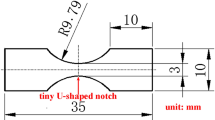Abstract
The effect of thermal mismatch induced residual stresses on grain boundary microcracking in titanium diboride (TiB2) ceramics has been studied by finite element method. A cohesive zone model was used to simulate the microcracking initiation in four-point bending specimens. In particular, the microcracking was assumed to occur at a grain boundary which is located in the center of the specimen, surrounded by a thermally anisotropic area. The predicted failure strength appears to be significantly reduced by the presence of residual stresses when the cohesive energy of the microstructure is small. The failure load from experiments has been used to determine the critical damage parameters for microcracking initiation in both pristine and aluminum-infiltrated TiB2. A viscous regularization technique is employed in the simulations to improve the rate of convergence of the solution and the effect of the value of the viscosity parameter on the simulation results, has been investigated. The effect of grain size, grain orientation, and number of employed thermally anisotropic grains, on the microcracking is also discussed.














Similar content being viewed by others
References
Baumgartner HR (1984) J Am Ceram Soc 67:490
Pettersen G (1997) Development of microstructure during sintering and aluminum exposure to titanium diboride ceramics. PhD Thesis, NTNU, Trondheim, NO
Jensen M, Pezzotta M, Zhang ZL, Einarsrud M-A, Grande T (2008) J Eur Ceram Soc 28:3155
Evans AG (1978) Acta Metall 26:1845
Fu Y, Evans AG (1985) Acta Metall 33:1515
Laws N, Lee JC (1989) J Mech Phys Solids 37:603
Clarke DR (1980) Acta Metall 28:913
Pezzotta M, Zhang ZL, Jensen M, Grande T, Einarsrud M-A (2008) Comput Mater Sci 43:440
Turon A, Davila CG, Camanho PP, Costa J (2007) Eng Fract Mech 74:1665
Alfano G, Crisfield MA (2001) Int J Numer Methods Eng 50:1701
Chaboche JL, Feyel F, Monerie Y (2001) Int J Solids Struct 38:3127
Gao YF, Bower AF (2004) Modell Simul Mater Sci Eng 12:453
Samimi M, van Hal BAE, Peerlings RHJ, van Dommelen JAW, Geers MGD (2007) An enriched cohesive zone model for numerical simulation of interfacial delamination in Microsystems. In: International conference on thermal, mechanical and multi-physics simulation experiments in microelectronics and microsystems, EuroSime2007, 16–18 April, London, UK
Munro RG (2000) J Res Natl Stand Technol 105:709
ABAQUS (2006) User’s analysis manual, version 6.6
Hilleborg A, Modeer M, Petersson PE (1976) Cem Concr Res 6:773
Hu X, Duan K (2008) Int J Fract 154:3
Kovalev S, Ohji T, Yamauchi Y, Sakai M (2000) J Mater Sci 35:1405. doi:https://doi.org/10.1023/A:1004758831048
Acknowledgement
This study is part of the research project (2003–2008) ThermoTech (Thermodynamics Applied to High Temperature Materials Technology) at the Norwegian University of Science and Technology (NTNU), Trondheim.
Author information
Authors and Affiliations
Corresponding author
Rights and permissions
About this article
Cite this article
Pezzotta, M., Zhang, Z.L. Effect of thermal mismatch induced residual stresses on grain boundary microcracking of titanium diboride ceramics. J Mater Sci 45, 382–391 (2010). https://doi.org/10.1007/s10853-009-3952-3
Received:
Accepted:
Published:
Issue Date:
DOI: https://doi.org/10.1007/s10853-009-3952-3




